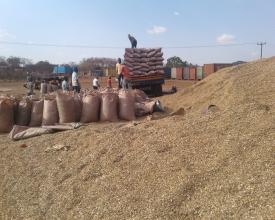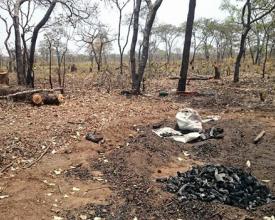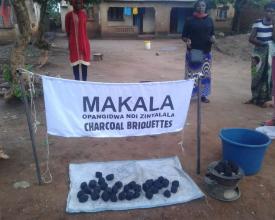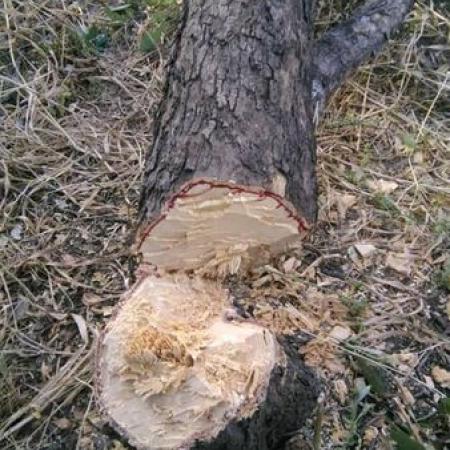
Transformar los hogares malawianos con bajos ingresos del uso de carbón de leña forestal al uso de briquetas de carbón para preservar los hábitats naturales de los animales y el ecosistema.
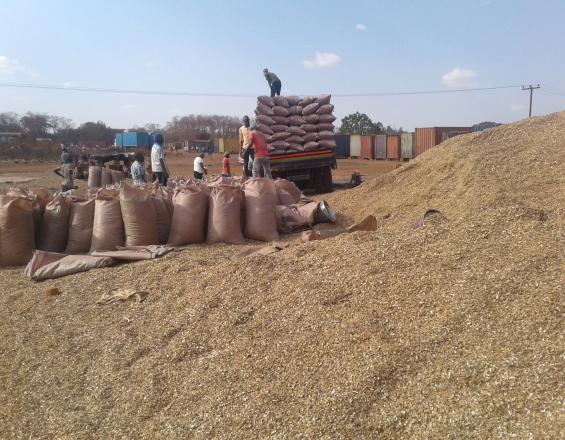
Recogemos de los agricultores residuos agrícolas como cáscaras de arroz, cáscaras de cacahuete, mazorcas de maíz y tallos de maíz. Les añadimos valor y producimos briquetas de carbón vegetal para reducir la tala de árboles para leña. Las briquetas de carbón vegetal son una fuente de energía sostenible y fiable que ayuda a sustituir el uso de la leña,
Con la adopción de briquetas de carbón vegetal fabricadas a partir de residuos agrícolas, se protegen los frágiles bosques y se preservan los hábitats naturales de las especies animales, al tiempo que se satisfacen las necesidades energéticas y de ingresos de la creciente población.
Las mujeres y los jóvenes que antes se dedicaban a talar los árboles de los bosques trabajan ahora en las instalaciones de producción o como vendedores de briquetas de carbón vegetal. 32.000 hectáreas de cubierta forestal que Malawi pierde cada año se regeneran, preservando el hábitat natural de distintas especies animales y vegetales.
Contexto
Défis à relever
Malawi tiene una población de 18,6 millones de habitantes y se espera que se duplique para 2038. Aún destaca la escasez de energía, ya que alrededor del 11,4% de la población tiene acceso a la electricidad. Debido a ello, la población utiliza los bosques como fuente de energía barata para cocinar. Esto ejerce presión sobre los limitados recursos naturales, lo que ha afectado negativamente al hábitat natural de especies animales y vegetales.
Malaui sigue siendo uno de los países más pobres cuya economía depende en gran medida de la agricultura y es vulnerable a las perturbaciones climáticas, que han obligado a la mayoría de los jóvenes y las mujeres a dedicarse a la venta de carbón y leña, lo que ha provocado la deforestación.
Uno de los mayores problemas medioambientales de Malawi es la deforestación. Anteriormente, Malawi estaba muy poblado de bosques y gran parte del país estaba cubierto de ellos. La madera es el principal combustible en Malawi, y el 95% de los hogares siguen utilizando madera o carbón para cocinar, lo que contribuye a uno de los retos medioambientales a los que se enfrenta Malawi.
Ubicación
Procesar
Resumen del proceso
Agricultores y fuentes de materias primas. Nuestra producción depende de la disponibilidad de residuos agrícolas que los agricultores consideraban inútiles. Si los agricultores queman estos residuos, nos resultará difícil obtener las materias primas para la producción.
Transporte y producción. El transporte desempeña un papel fundamental en la recogida de las materias primas hasta las instalaciones de producción. Es difícil llegar a las zonas dispersas en busca de materias primas sin medios de transporte adecuados.
Producción y venta al por menor. Es importante que haya producción para que los productos estén a disposición de los clientes. También es necesario el transporte para llegar a estos puntos de venta.
Concienciación y compra por parte de la comunidad. Si los miembros de la comunidad no son conscientes de la disponibilidad de briquetas de carbón y de sus ventajas para la conservación de la biodiversidad, la iniciativa no crecerá.
Disponibilidad de mano de obra y producción. Si no se dispone de mano de obra, la producción de briquetas de carbón vegetal se verá obstaculizada, especialmente en las áreas de recogida, secado y envasado de residuos agrícolas.
Bloques de construcción
El proceso de conservación de la biodiversidad mediante la producción de briquetas de carbón vegetal Makala
Entender las razones de la invasión de los bosques: La fuerza motriz es la necesidad de leña. Para resolver estos dos problemas, la gente recurre a la tala de árboles para obtener leña, lo que afecta al hábitat natural de plantas y animales.
Selección del emplazamiento: Se tiene en cuenta la selección de un emplazamiento cercano a la fuente de materias primas y a la población objetivo, así como la construcción de estructuras.
Obtención de materias primas. El primer paso consiste en determinar la disponibilidad potencial de residuos agrícolas que puedan utilizarse en el proceso de producción de briquetas.
Procesamiento y producción Esto implica la clasificación y trituración. A continuación, los materiales clasificados se prensan en briquetas que se envían a secar y se someten a pruebas para establecer la durabilidad de las briquetas.
Participación de la comunidad: La durabilidad de las briquetas para la comunidad se realiza mediante demostraciones participativas de cocina. Se invita a los líderes comunitarios a explicar los beneficios.
Conservación de la biodiversidad: Cuando las comunidades se dan cuenta de que las briquetas satisfacen sus necesidades culinarias y laborales, dejan de talarse árboles, con lo que se preservan los hábitats naturales de especies animales y vegetales.
Factores facilitadores
La concienciación de la comunidad es el factor de éxito más importante. Otros factores son la disponibilidad continua de las briquetas, ya que cualquier retraso en su distribución hará que la comunidad vuelva a su antiguo sistema.
Los gobiernos y los organismos donantes tienen que intervenir y apoyar este tipo de iniciativas.
Fuentes alternativas de materias primas. Los residuos agrícolas son estacionales, lo que exige recoger grandes cantidades cuando están disponibles o encontrar sustitutos para seguir produciéndolos.
Lección aprendida
La pasión es la fuerza motriz. La mayoría de las comunidades han arraigado en sus culturas tradicionales que los bosques son las únicas fuentes de leña y de generación de ingresos. Es difícil convencer a estas personas para que cambien. Sin pasión y compromiso, los proyectos pueden fracasar porque la aceptación lleva mucho tiempo.
Es necesario ofrecer incentivos a las comunidades, como animarlas a practicar negocios agroforestales que sirvan para conservar especies raras de animales y plantas que puedan servir para atraer turistas.
Uno de los retos es el fracaso a la hora de establecer asociaciones con los proveedores de materias primas, ya que resulta difícil cuando las fuentes están dispersas y desorganizadas.
Principales recursos de apoyo a la producción de briquetas de carbón vegetal para la conservación de la naturaleza
Los agricultores. Los agricultores son los actores clave en este proceso para la producción de residuos agrícolas que se utilizan como nuestras materias primas.
Sistemas de transporte organizados: Las fuentes de materias primas están siempre dispersas y hay que recogerlas y transportarlas a las instalaciones de producción. Esto requiere consolidarlas para facilitar su transporte. Se necesitan medios de transporte fiables que se utilicen con eficiencia y eficacia.
.
Puntos de venta y centros de distribución. Una vez producidas las briquetas, los miembros de las comunidades deben poder acceder a ellas sin problemas. Esto requiere la contratación de minoristas que almacenen estos productos.
Mecanismos de fijación de precios. Cambiar a las comunidades a las nuevas fuentes alternativas de energía para cocinar requiere ofrecerles un precio reducido que les atraiga. Para conseguirlo, los empresarios deben plantearse minimizar sus costes de producción analizando el proceso de producción.
Requiere mucha mano de obra. El proceso de recogida de materias primas de los agricultores requiere mucha mano de obra. La carga y descarga de los camiones también requiere mano de obra, así como la clasificación de las materias primas. El envasado del producto también requiere mucha mano de obra.
Factores facilitadores
Buenas precipitaciones para los residuos agrícolas. Los cambios climáticos provocados por factores como la deforestación han afectado a los regímenes de precipitaciones, lo que ha reducido las cosechas.
La formación de asociaciones ayuda a establecer fuentes permanentes y fiables de materias primas.
Disponibilidad de puntos de venta al por menor al alcance de los miembros de la comunidad.
Disponibilidad de mano de obra para unirse a la elaboración de briquetas de carbón vegetal, que siempre se considera un trabajo sucio.
Lección aprendida
Para garantizar la cobertura de los puntos de venta al por menor, se supo que los vendedores de leña establecidos son los más indicados para ser contratados. Tienen experiencia en la venta de leña y pueden influir fácilmente en sus clientes para que empiecen a utilizar briquetas de carbón para salvar el medio ambiente. Sin embargo, uno de los retos a los que se enfrentan es que algunos minoristas ven la introducción de briquetas de carbón como una amenaza para su negocio establecido.
Otro reto es que los transportistas tienden a subir sus precios cuando descubren que los residuos que les contratan para transportar se convierten en dinero. Aquí es donde importa la necesidad de un sistema de transporte organizado.
Se ha observado que la mayor parte de la mano de obra disponible procede de las mujeres, lo que brinda la oportunidad de capacitar a los hombres para que realicen los trabajos que siempre han hecho los hombres.
Impactos
Se preserva el hábitat natural de las especies animales. La deforestación conduce directamente a la pérdida de biodiversidad cuando las especies animales que viven en los árboles dejan de tener su hábitat y, por tanto, se extinguen, y también lleva a ciertas especies arbóreas a desaparecer definitivamente.
Los seres humanos están protegidos del contacto con los animales salvajes. Los principales impactos sobre la biodiversidad proceden de los conflictos entre el hombre y la fauna silvestre relacionados con la continua invasión humana de ecosistemas frágiles que hace que los seres humanos entren cada vez más en contacto con la fauna silvestre.
Se contiene la pérdida de agua y la erosión. La tala de árboles, principalmente para la producción de carbón vegetal, ha provocado la tala de grandes extensiones de bosques, destruyendo todas las zonas de captación de agua y provocando escasez de agua para los animales de los bosques.
Se fomenta la forestación de tierras debido a la concienciación de la población sobre la necesidad de satisfacer las necesidades energéticas como fuente alternativa, lo que reduce la presión sobre los bosques y contribuye a la conservación de la biodiversidad.
La solución promueve la agrosilvicultura y el cultivo de árboles como actividad empresarial.Los bosques que albergan especies animales naturales y diferentes tienden a atraer a los turistas. El turismo contribuye así a mejorar los medios de subsistencia de las comunidades.
Beneficiarios
Hábitats naturales preservados
Las mujeres y las niñas ya no entran en los bosques ni sufren acoso
Las niñas tienen tiempo para estudiar
Las mujeres y los jóvenes comercian con briquetas legalizadas
Creación de actividades de turismo forestal
Zonas de captación de agua sostenidas
Preservación de especies raras
Objetivos de Desarrollo Sostenible
Historia

En 1975, muchos de nuestros padres se dieron cuenta de que había oportunidades económicas en Lilongwe tras su fundación como capital de Malawi. Muchos de ellos se asentaron en las zonas circundantes, como Kawale Biwi, Chinsapo y otras. Dependían de la leña que se conseguía fácilmente en los arbustos de los bosques y a lo largo de los ríos circundantes, donde vivían diferentes especies de criaturas. La población empezó a crecer y los arbustos disminuían, lo que alejaba a los animales y otras criaturas a otras zonas donde se sentían protegidos.
Con el aumento de la población, las empresas no podían emplear a toda la gente. Y con el mismo aumento de población, aumentó la necesidad de energía para cocinar. Sumadas estas dos necesidades, las reservas forestales naturales se convirtieron en objetivos como fuente de empleo y fuente de leña para cocinar. Con el paso del tiempo, los bosques se están convirtiendo en desiertos.
La deforestación ha contribuido al cambio climático en Malawi. El régimen de lluvias ha cambiado, ya que las precipitaciones no son fiables y caen durante cortos periodos de tiempo. Esto ha afectado al entorno natural y ha provocado la extinción de animales y otras criaturas por falta de alimentos y protección. La deforestación ha afectado al ecosistema y muchas criaturas del bosque han perdido sus hábitats naturales, afectando así a todo el sistema. Además, Malawi es un país dependiente de la agricultura y los problemas de precipitaciones afectan al ritmo de las cosechas, lo que a su vez repercute en la población humana.
Las briquetas de carbón vegetal MAKALA son la solución: proporcionan energía barata para cocinar y fuentes de ingresos a empleados y minoristas, y reducen la deforestación, ya que no se talan árboles, preservando así los hábitats naturales de las criaturas del bosque.
